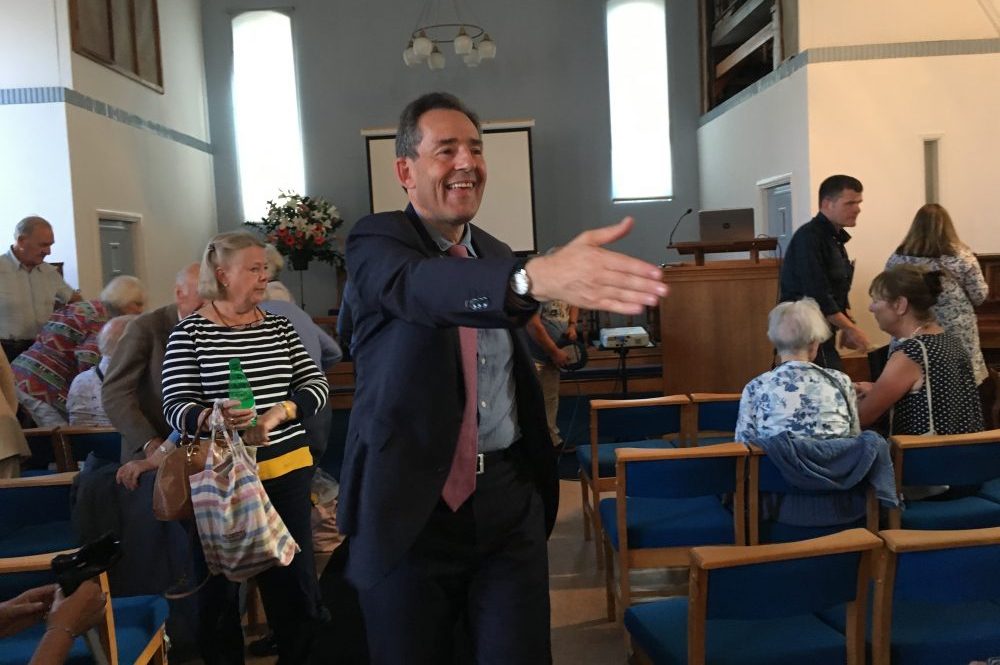Mr John Benjamin, known to the public as the jewellery expert on BBC 1’s Antiques Roadshow, came to the Rye Festival to talk about ‘Jewellery from Elizabeth I to Elizabeth Taylor’, on September 17 in the Methodist Hall.
Mr Benjamin, a jewellery valuer and an expert in his field, started his talk by making some general points. He reminded the large audience that jewellery is a global commodity, is easily portable and if of good quality, holds or even increases in value, and to whet the appetite, showed a picture of a flawless 100 carat diamond, which would sell to the dealer at $200,000 per carat. Explaining how diamonds were categorised, the one he had shown was a D grade, so had no colour and was the real ‘grown up’ deal. The retail price would be much higher than the $200,000 he had just quoted.
He followed this with pictures of Queen Elizabeth I in all her glory, using her pieces to demonstrate her power and authority. She was adorned with a double string of pearls, and Mr Benjamin used this to explain about natural and cultured pearls. Up until 1921, all pearls were natural, but Mr Mikimoto introduced the cultured pearl in 1921.
Apparently, and in answer to a question by Mr Benjamin to the audience, most had pearl necklaces of cultured pearls and so of little value! A questioner at the end asked if any of the jewels remained intact, but it seems sadly not. The pearls had been incorporated into other pieces.
He used this image of the Queen and more pictures to show Renaissance jewellery, adorned with enamels to represent real jewels, colourful and ornate. He also pointed out that the gold used in this era was pure, soft and heavy, unlike the 18 carat and 9 carat gold in use today.
Moving forward, we were told of the magic and talismanic jewellery. Garnets against the skin stop nightmares, peridot assisting with conjugal love, all in set into a ‘prophylactic pendant’. There is ‘mythological jewellery’, with references in the design and jewels to love or religion. After all, as Mr Benjamin said, if you really believe these jewels will help you sleep peacefully, you probably will.
Jewellery of the 17th century from 1600 to 1620 is hard to find, as it was destroyed during the Protectorate of Oliver Cromwell, because it was a blasphemy to wear it. In June, 1912, underneath a house in Cheapside, London a hoard of 17th-century jewels was found in a leather wallet in the London clay. Known as ‘the Cheapside Hoard’, no one knows why they were buried there, but it has great historical significance.
Mr Benjamin spoke of the development of diamond cutting in the 18th century and how in 1740 to 1750 the first examples of faking arose. He advised the audience to look more closely at the jewellery of the period of William IV and Queen Adelaide, often passed over.
Moving on to the 19th century, we came to the era of romantic jewellery design, and an obsession with the language of flowers, with at the end of the century the popularity of designs of animals and birds.
This era saw new money enter the market, and the desire to show off wealth. A superfluity of design led to the Arts and Crafts movement jewels. Simple, modest and understated, they is now very desirable and often bear the name of Liberty and Co. In Europe, this was the period of Art Nouveau, more sexy and sophisticated.
A brand new metal, platinum, introduced in the early 19th century, changed the course of jewellery design and has never lost its popularity. The 1920s produced jewellery of technical virtuosity, elegant, art deco and still popular. The war years were difficult for jewellers, as many of the craftsman were Jewish and murdered in the Holocaust.
After the war, women were more independent and started to buy their own jewellery. During this time, jewellers had to diversify, to include gifts and other items to attract and retain customers, as everyday jewellery was the order of the day. The 1950s to 1960s saw the era of the glamour puss, seen in the Hollywood films and stills, and the late 1980s and 1990s saw the auction sales of the collections of people such as the Duchess of Windsor and Elizabeth Taylor, with astonishing sums of money being raised.
John Benjamin was amusing, erudite and an excellent speaker, and it is difficult to do justice to his knowledge in a short article. He had really interesting and informative images, involving the audience in his talk to good effect. If he comes again to a venue near you, and you have an interest in jewellery, go and listen.
Image Credits: Gillian Roder .



